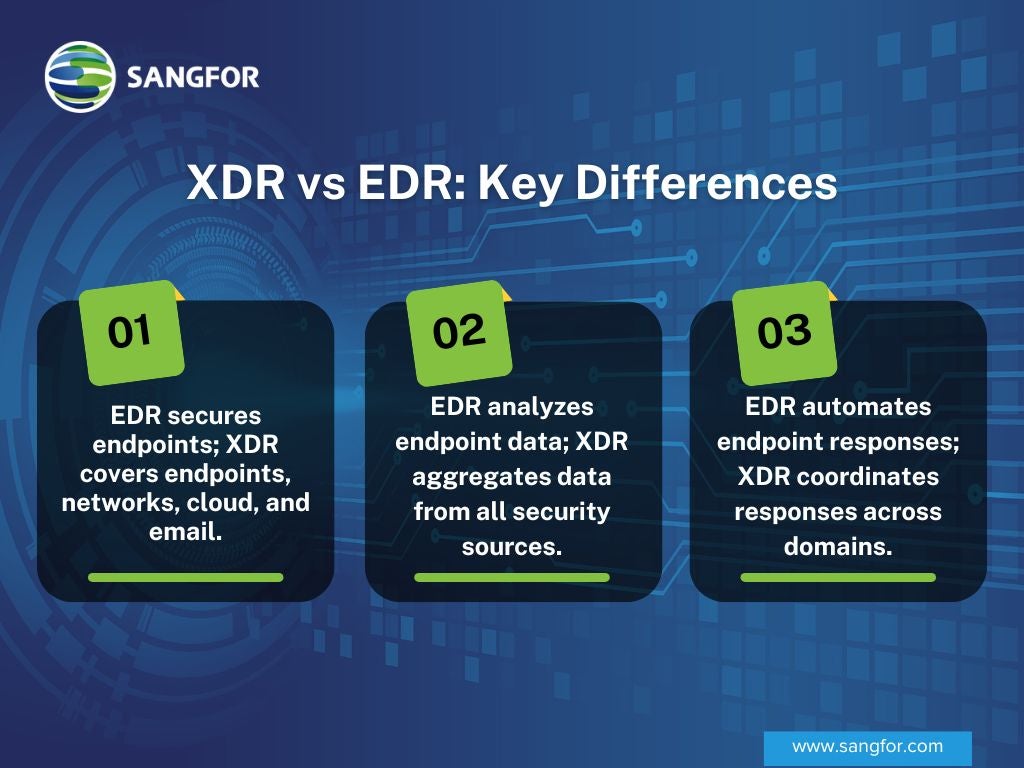When it comes to the comparison of "XDR vs EDR," it's about choosing the right cybersecurity tool for your needs. EDR focuses on detailed endpoint protection, while XDR offers a broader, integrated defense across your network and endpoints.
This guide helps you understand the differences between XDR and EDR, their applications, and how they fit into your security strategy, ensuring you're well-equipped to protect your digital environment.
Importance of EDR and XDR in Cybersecurity
In the digital age, the security perimeters of organizations have expanded well beyond physical offices into the cloud, making every endpoint and network component a potential entry point for cyber threats. EDR and XDR serve as strategic solutions that offer a layered defense mechanism against these evolving threats.
EDR systems offer granular visibility and control over endpoints, acting as the defense to identify and mitigate device-level threats. EDR solutions also support automated threat detection and response to efficiently handle endpoint-specific incidents. XDR merges data across endpoints and various data sources to enable advanced detection and response of complex, multi-vector threats, enhancing overall security posture.

What Is Endpoint Detection and Response (EDR)?
EDR is a cybersecurity solution that monitors suspicious activities on endpoints, including computers, servers, and laptops and provides resources to address any threats that are found. EDR solutions swiftly identify, investigate, and address security incidents on endpoints using various technologies, including machine learning, threat intelligence, and behavioral analysis.
How Does EDR Work?
EDR functions through a multi-step process, beginning with the deployment of agents on endpoints to monitor and gather data on all activities. This data is then analyzed using sophisticated detection algorithms that identify anomalies indicative of potential threats. Upon detection, alerts are generated, providing detailed insights into the nature and scope of the danger.
Use Cases of EDR
The following points illustrate the diverse applications of EDR technologies:
- Threat Hunting: Security teams employ EDR tools for proactive threat detection within the endpoint ecosystem. They identify potential threats by analyzing endpoint data in real-time for signs of suspicious activity.
- Incident Investigation and Response: Post-incident, EDR provides detailed insights into endpoint activities, aiding in identifying the incident's root cause and facilitating effective containment and remediation efforts.
- Behavioral Analysis: By monitoring endpoint behavior and detecting deviations from established norms, EDR identifies potential threats, including malware and insider attacks, enhancing overall security posture.
- Threat Intelligence Integration: EDR platforms enhance detection capabilities by integrating with threat intelligence feeds, identifying known threat indicators, and enabling proactive defense measures.
- Compliance Auditing: EDR assists in regulatory compliance, offering detailed visibility into endpoint activities and generating reports to demonstrate compliance with industry standards.
What Is Extended Detection and Response (XDR)?
Building upon the capabilities of EDR systems, XDR represents an evolution in cybersecurity, offering a comprehensive security solution that goes beyond endpoints. It provides a centralized and cross-domain approach to threat detection and response by including data from multiple security domains, such as endpoints, networks, clouds, emails and other data sources.
How Does XDR Work?
XDR extends the capabilities of EDR by incorporating data from a wider array of sources. It starts with the aggregation of security data, which is then subjected to advanced analytical processes to identify threats. A key feature of XDR is its ability to correlate disparate data points, linking events across different domains to unveil complex attack patterns. XDR is able to detect and correlate security events beyond what EDR solution is able to detect.
Automated response mechanisms are a hallmark of XDR, enabling swift containment and mitigation across the organization's digital estate. Additionally, XDR's centralized management platform streamlines operations, providing a single pane of glass for security teams to monitor, investigate, and respond to threats.
Security Information and Event Management (SIEM) systems are often integrated with XDR to enhance its capabilities. SIEM provides a centralized platform for collecting and analyzing security data from across the organization, offering a comprehensive view of potential threats. This integration allows XDR to leverage SIEM’s extensive data collection and correlation capabilities, improving the accuracy and efficiency of threat detection and response.
Use Cases of XDR
With an evolutionary leap from EDR in cybersecurity, XDR supports the digital landscapes of various organizations. Key use cases include:
- Unified Threat Visibility: By integrating data from various security sources, including EDR, NDR (Network Detection and Response), and cloud security, XDR offers a centralized overview of security events, enabling holistic event analysis and correlation.
- Cross-Layer Detection and Response: XDR facilitates the detection and remediation of threats across multiple environments, such as endpoints, networks, and cloud services, by aggregating and correlating data for faster and more accurate threat management. XDR's continuous monitoring capability across the entire attack surface ensures timely detection of suspicious activities, enabling proactive threat mitigation and breach prevention.
- Automated Threat Remediation: Leveraging automation, XDR streamlines the containment and eradication of threats across different security layers, reducing response times and minimizing the potential for error.
- Scalable Security Operations: XDR enhances the efficiency of security operations, enabling teams to manage the growing volume and complexity of threats more effectively through integrated tools and optimized workflows.
Evolution from EDR to XDR
The progression from EDR to XDR reflects the increasingly complex nature of cyber threats and the need for a more comprehensive security approach. EDR solutions first arrived to monitor and manage breaches and attacks on endpoints. XDR broadens this scope, going beyond integrating data across multiple security domains for protection.
XDR provides a unified and cross-defense mechanism against multifaceted threats, which is increasingly important in the modern technological environment, where organizations rely on interconnected networks, cloud infrastructures and a wide range of digital tools and applications to enable hybrid and remote working modes.
XDR vs EDR: Key Differences
When comparing EDR and XDR, you will become aware of the numerous differences between them in several critical aspects.

Scope of Coverage
EDR is tailored to fortify the security of individual endpoints within an organization’s network, acting as a vigilant guard against threats targeting devices like computers and servers. In contrast, XDR takes a broader stance, integrating security efforts across a more extensive array of domains, including not just endpoints but also networks, cloud services, and email systems. This expansive approach allows XDR to offer a more comprehensive shield against cyber threats, covering a wider surface area for potential attacks.
Data Sources Analyzed
EDR focuses on data emanating from endpoints. This includes monitoring user activities and system events and analyzing network traffic specific to these endpoints. On the other hand, XDR casts a much wider net, pulling in data from across the security ecosystem, including network traffic, cloud services, email, and other integrated security tools. This holistic aggregation of data under XDR enables a more nuanced analysis of the security landscape, providing deeper insights into potential threats.
Automation and Response Capabilities
EDR provides a level of automation in responding to incidents, primarily at the endpoint level. This includes capabilities for isolating affected devices or terminating malicious processes. XDR, however, elevates this with advanced automation and orchestration capabilities, enabling swift, coordinated responses to threats across various domains. XDR's integrated approach allows for seamless coordination between different security tools, streamlining the response process and reducing the time from detection to remediation.
EDR or XDR
Deciding between EDR and XDR is not a straightforward question. It requires a deeper understanding of your own organization’s unique security landscape. The differences between these two solutions mean that each is better suited for an organization with a specific security posture, infrastructure complexity, and resource availability.
For enterprises looking to adopt a more integrated approach to security that transcends traditional endpoint protection, XDR stands out as the solution of choice. XDR is designed to provide a comprehensive view of an organization's security status, making it ideal for complex IT environments where threats can span multiple domains, from endpoints to cloud infrastructures. Organizations with the necessary resources and expertise to deploy and manage such an expansive system will find XDR's broad coverage and deep integration capabilities particularly beneficial, offering deep visibility and easy access to data.
Conversely, EDR may appeal more to organizations at the early stages of developing their cybersecurity frameworks or those with simpler IT infrastructures primarily centered around endpoint protection. EDR solutions offer robust defenses against threats at the endpoint level, providing detailed insights into device-level activities and potential vulnerabilities. This makes EDR particularly suitable for organizations with limited resources or those lacking in-depth security expertise required to manage more comprehensive solutions like XDR. EDR ensures that even with constrained resources, organizations can achieve a high level of security efficacy.
Factors to Consider When Choosing Between EDR and XDR
While deciding between EDR and XDR requires a deep understanding of various aspects of your own organization, here are several key factors that can help with your decision-making process:
- Security Needs and Goals: Assess the spectrum of cyber threats faced and the requisite level of security visibility and control.
- Existing Security Infrastructure: Examine how an EDR or XDR solution would integrate with and augment current security measures.
- Resource Availability: Evaluate the organization's capacity in terms of budget, technical expertise, and operational bandwidth to deploy and manage these solutions.
- Scalability and Flexibility: Ensure that the chosen solution can scale in tandem with the organization’s growth and adapt to evolving security needs.
Future Trends of EDR and XDR
As the cybersecurity landscape continues to evolve, EDR and XDR solutions are expected to incorporate several advanced technologies and methodologies to stay ahead of emerging threats.
- Integration of AI and Machine Learning: AI and machine learning are becoming integral to EDR and XDR solutions, enabling more sophisticated threat detection and response. These technologies help in identifying patterns and anomalies that traditional methods might miss.
- Increased Automation: Automation is a key trend, with EDR and XDR systems increasingly capable of responding to threats without human intervention. This reduces response times and allows security teams to focus on more complex tasks.
- Broader Data Integration: XDR solutions are expanding to include a wider range of data sources, such as cloud environments, network traffic, and email systems. This comprehensive approach provides better visibility and context for threat detection.
- Enhanced Threat Intelligence: Improved threat intelligence sharing and integration are helping organizations to proactively hunt for threats and respond more effectively. This trend is crucial for staying ahead of sophisticated cyber attacks.
- Focus on Zero Trust Security: The adoption of zero trust security models is influencing the development of EDR and XDR solutions. These models require continuous verification of all users and devices, which EDR and XDR systems are increasingly supporting.
- Scalability and Flexibility: Future EDR and XDR solutions are designed to be more scalable and flexible, accommodating the diverse and growing needs of modern IT environments. This adaptability is essential for organizations of all sizes.
How Can Sangfor Help You with Our EDR and XDR Solutions?
Sangfor Endpoint Secure and Sangfor Omni-Command XDR solutions epitomize the integration of advanced cybersecurity measures tailored to meet the dynamic security requirements of modern organizations. Endpoint Secure provides a robust defense mechanism against malware and APT threats at the endpoint level, while Sangfor XDDR, a framework that goes beyond traditional XDR by implementing a real integrated security solution, extends this protection and encompasses the entire network.
Learn about Sangfor’s solutions today to achieve a balanced and effective cybersecurity posture that is capable of combating the most sophisticated threats.
Frequently Asked Questions
EDR focuses on detecting and responding to threats at the endpoint level, such as computers and mobile devices.
XDR enhances security by integrating and analyzing data from multiple sources, including endpoints, networks, and cloud environments, for a comprehensive threat response.





